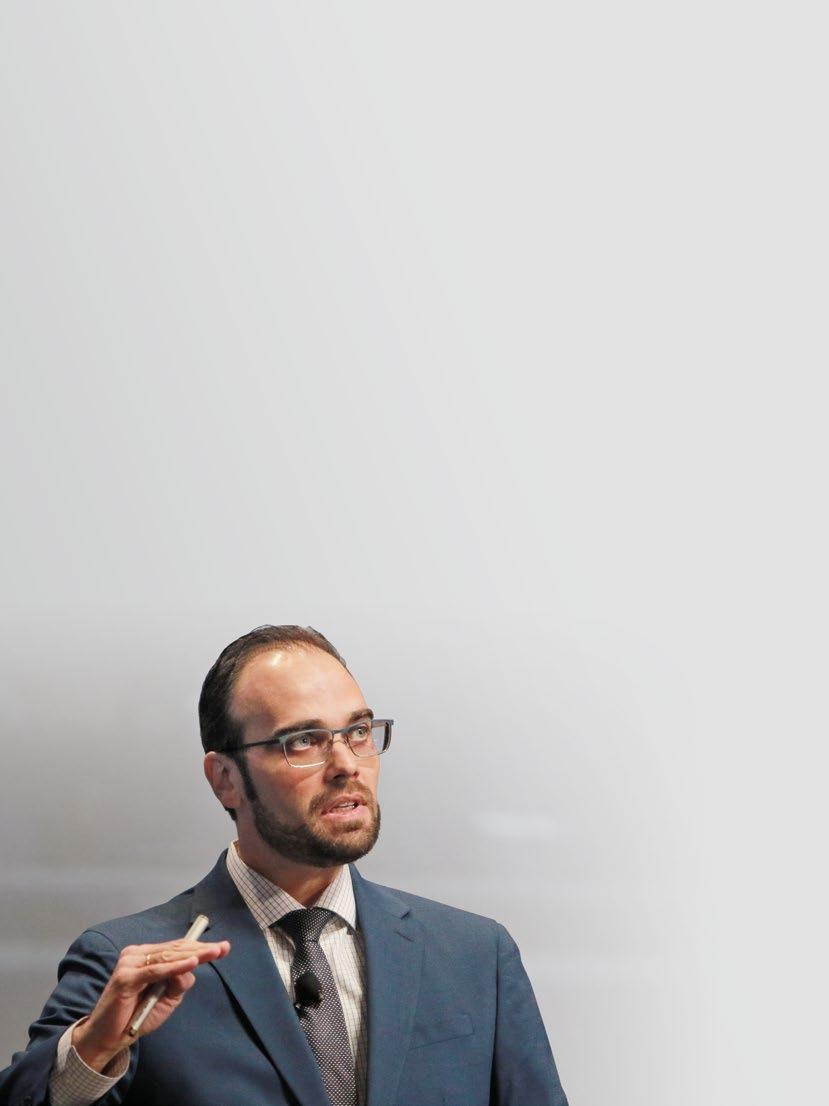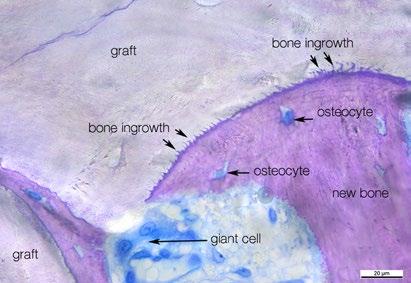
11 minute read
Orthodontic tooth movement makes new bone formation
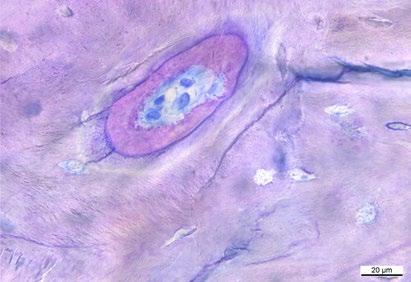
Histology Orthodontic tooth movement makes new bone formation
Dr. Pal Nagy DMD | Hungary Department of Periodontology Semmelweis University
FIG. 1
FIG. 2
FIG. 1: An intimate contact of new bone to graft paticles was observed, characterized by bone extensions growing into the graft surface. FIG. 2: Cross section of the repairing part of remodeling “cutting cone.” Osteoblasts secreting the newly formed woven bone. Histologic images were obtained during an ongoing randomized controlled trial. After flap elevation, debridement of the root surface and removal of the granular tissues, non-containing intrabony defects were filled with Geistlich Bio-Oss® and covered with Geistlich Bio-Gide® . 1 Patients in the test group underwent postoperative Orthodontic tooth movement (OTM). In the control group, teeth remained splinted without OTM.
At 9-month re-entry, bony core samples were harvested and analyzed. Geistlich Bio-Oss® was integrated into the newly formed bone in both groups. In the test group, the ratio of de novo bone formation was higher, and postoperative OTM appeared to induce remodeling interfering with the graft and promote new bone formation, particularly at compression sites.
Reference 1 Nagy P, et al.: Int J Periodontics Restorative Dent. 2019 11;40(3):321–30. (clinical study)
Five experts practicing in the pandemic

Coronavirus pandemic has hit everyone in the healthcare industry to some extent. It changed how we live, work, and socialize. We asked five clinicians from five countries about the impact of the pandemic on their professional lives as dental practitioners.
Dr. Liliana Aranguren | USA Periodontist and Dental Implant Surgeon in South Florida USA
> First confirmed case on 21 January, 2020 > 72 620 Confirmed cases/1 million population* > 398 435 Deaths
Dr. Aranguren: We closed for all routine and non-essential care. We were available only for emergencies under high levels of disinfection. It was important to act quickly, as we always feel a great sense of responsibility to act in the best interest and safety of our patients, colleagues and community.
How did you communicate that with your patients?
We sent letters and emails, made phone calls and constantly updated our website with the latest information and the latest protocols we adopted to continue to provide the best service.
It was a slow process. We modified the schedules and appointments to reduce the traffic in the reception area, allowed more time for disinfection and maintained social distance for the safety of our patients and team. We also invested in new and improved Personal Protection Equipment (PPE) and ventilation systems. Gladly I can say that we are now back and providing the highest levels of infection control.
We adopted a multi-tiered approach: temperature taken from each patient and team member, sanitization stations throughout the office, new PPE worn by all team members, installation of stateof-the art air purifying units with extraoral high evacuation units to absorb dental aerosols and contaminants, and periodic office “floggings” with hypochlorous acid, as is done in hospitals for maximum disinfection. Magazines, coffee makers and handouts were also removed from all the waiting rooms, and patients were asked to wear masks before entering the office.
I have learned that in order to survive we need to evolve and adapt to the circumstances. These have been weird times, but I can gladly say they have taught my team and me that through resilience, pride and professional dedication, we can overcome almost anything.
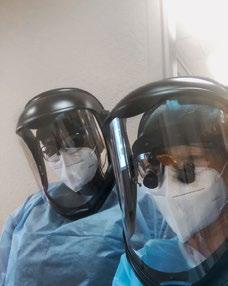
“Our work during this period gave us a sense of accomplishment.”
Dr. Safa Somi | United Kingdom Specialist in prosthodontics at Harrow Dental Practice UNITED KINGDOM
> First confirmed case on 31 January, 2020 > 51 642 Confirmed cases/1 million population* > 93 290 Deaths
Dr. Somi: All of a sudden we had to close the practice for everyone, even for the patients who were halfway through their treatments. Lockdown was a very stressful time for everyone, plus it imposed a large financial burden on us.
How did you communicate that with your patients?
First, we called our patients and canceled appointments. Of course, everyone in the beginning was in shock. And when this state was over, we started to think of preparing ourselves for the next. We prepared patient videos, so they could understand what to expect when we re-opened. We informed them about the safety measures we had put in place. We wanted them to know that the dental office was one the safest places they could go.
During lockdown we used the time and carefully planned a sound re-opening strategy. We installed best-in-class, cross-infection-control equipment. We trained our staff. So upon re-opening, our patients realized this hard work, acknowledged it and felt safe to come back. We had a lot of positive feedback from our patients, e.g., in Google reviews of the clinic in recent months. They wrote to say how safe they felt, which encouraged new patients to come to our practice.
We ordered air purifiers, extra oral suctions, PPE masks and all our other cross-infection-control equipment, despite the financial burden. We accepted fewer patients per day. Also, we didn’t use the waiting room anymore: patients were immediately escorted to the treatment room when they arrived.
We are still learning to live with this “new normal.” One of my lessons was overcoming panic and replacing it with anticipating the future. We also learned that investing in high-end safety measures pays back by creating more patient trust.
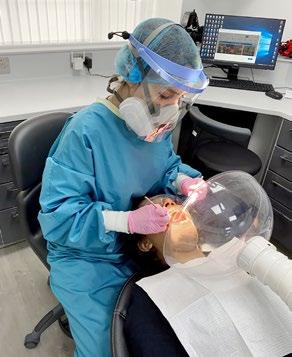
Working in mask, and near extra oral suction equipment.
AUSTRALIA
> First confirmed case on 25 January, 2020 > 1127 Confirmed cases/1 million population* > 909 Deaths
Dr. Alistair Graham | Australia Dental surgeon in Mona Vale

“During restrictions, we could only relieve pain and infections, but it was great to be able to help the community in our small way.”
Dr.Graham: The virus came slowly to Australia. It was only in March 2020 that the number of cases in New South Wales increased. Regulations then allowed us to accept only emergency cases for about six weeks. Afterward we could re-open under strict conditions, e.g., for non-aerosol generating procedures.
How did you communicate with your patients?
First, we called the patients with standing appointments and informed them. Then we created e-mail newsletters for all patients in our database. We also followed that up with social media posts. We wanted to stay connected with our patients and keep communicating with them. They were very understanding. The crisis affected everybody; they knew that we were affected too.
During the shutdown we stayed connected as a team, shared training and webinars and learned from each other. We followed all the safety protocols and communicated that we were doing so to our patients. But still we worried whether patients would want to come back. The opposite was true; they fully trusted us. That was nice to learn.
A lot of protocols, such as standard cross-infection control, extra personal protective equipment and sterilizing instruments, were always in place. In addition, we asked our patients to stay outside until we called them in for the treatment session. We also had more hand sanitizer available, and we took away unnecessary objects, such as water bottles and magazines in the waiting room, or a chair at the payment desk.
Appreciating the things we used to take for granted, like how we interact with our patients. Also, maintaining a high standard, whether in patient care or cross-infection-control protocols. We continuously reviewed our work and deliberately kept the team stimulated and challenged during the shutdown. This helped us stay prepared when we re-opened.
“Starting the working week with a zoom staff meeting. We discuss the emergency patients and how the week will operate.”
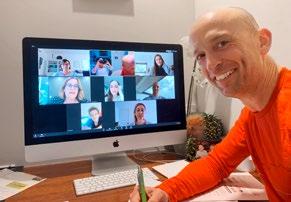
Dr. Marcelo Nunes | Brazil University professor and dental surgeon in São Paulo > First confirmed case on 26 February, 2020 > 40 336 Confirmed cases/1 million population* > 211 491 Deaths

“Longer intervals between patient visits reduced the risk of contact at reception.”
Dr. Nunes: The immediate impact was the sudden interruption of all my clinical and academic activities. It generated the need to find a quick way to adapt to the new conditions of online courses and events in general.
How did you communicate that with your patients?
Mainly via WhatsApp. We explained to the patients the risks and impacts on health caused by contagion of the new corona virus. protocol will remain and will allow us greater control over the risks of contagion. The current situation will provide a new setting that will generate less disease spread. From an economic perspective, the pandemic had an unprecedented financial impact on our patients. We had to revise the high-cost treatment protocols and adapt them to patient budgets, so as not to compromise financial reserves. What were the hygiene protocols you used to protect your team and patients?
Patient visits were distributed with longer intervals between patients, Upon reaching the clinic, patients are immediately taken to the bathroom for hand hygiene with antiseptics and 70 % alcohol gel. Air filtration and sterilization systems were implemented for the reception area and the clinic. All dental professionals and technical assistants must use the PPE recommended by the responsible authorities.
Leaving my comfort zone and adapting to the new reality of clinical practice and online events. I also had to look for new teaching methods that could maintain the quality, and the interaction with students.
The recovery of my practice came through a more rigorous clinical protocol for biosafety, which is currently perfectly manageable. I see that this new
CHINA
> First confirmed case in late November 2019 > 68 Confirmed cases/1 million population* > 4808 Deaths
Dr. Zhu Zhenghong | China The CEO of Taikang Bybo Dental
Dr. Zhu: From February to April we closed all clinics for general treatment, and until June for surgery. Taikang Bybo is the largest dental chain in China. With our huge costs, such as rental, utilities and labor, and no revenue, our cash flow was under great pressure.
How did you communicate that with your patients?
For example, we started to organize some livestream programs to answer the patients’ questions. Our focus was healthcare during the pandemic, so patients could understand how an office visit could be avoided or when emergency treatment was necessary. I was surprised that during our first stream we had 100 000 participants. This inspired me to launch an online program, i.e., a charity event, with all benefits donated to Wuhan.
Although it is now under control in China, this pandemic is a global crisis. It is unclear when it will end and how it will impact the oral health sector in the future. Something that helped our recovery after lockdown was the Taikang Bybo insurance model. In China, basic insurance does not cover the cost of most dental treatments. We launched our model, called “Heartwarming GO PLUS,” to cover a wide range of treatments for all family members in a prepaid plan. It also establishes better communication between our dentists and customers.
We strengthened our epidemic prevention and control measures. We established and expanded the online appointment and consulting platforms. Patients were precisely screened and triaged before treatment. Cross-infection control equipment was expanded. Also, all our healthcare staff took courses about prevention and control.
“Crisis” is a choice between “threat” and “opportunity.” We started to sensitively transform and digitize our work. We learned how to reduce losses, to recover and serve our patients, so as to finally overcome the challenge of the epidemic.

Patient’s temperature measured at reception.


